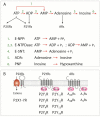Purinergic signaling pathways in endocrine system
- PMID: 25960051
- PMCID: PMC4536093
- DOI: 10.1016/j.autneu.2015.04.010
Purinergic signaling pathways in endocrine system
Abstract
Adenosine-5'-triphosphate is released by neuroendocrine, endocrine, and other cell types and acts as an extracellular agonist for ligand-gated P2X cationic channels and G protein-coupled P2Y receptors in numerous organs and tissues, including the endocrine system. The breakdown of ATP by ectonucleotidases not only terminates its extracellular messenger functions, but also provides a pathway for the generation of two additional agonists: adenosine 5'-diphosphate, acting via some P2Y receptors, and adenosine, a native agonist for G protein-coupled adenosine receptors, also expressed in the endocrine system. This article provides a review of purinergic signaling pathways in the hypothalamic magnocellular neurosecretory cells and neurohypophysis, hypothalamic parvocellular neuroendocrine system, adenohypophysis, and effector glands organized in five axes: hypothalamic-pituitary-gonadal, hypothalamic-pituitary-thyroid, hypothalamic-pituitary-adrenal, hypothalamic-pituitary-growth hormone, and hypothalamic-pituitary-prolactin. We attempted to summarize current knowledge of purinergic receptor subtypes expressed in the endocrine system, including their roles in intracellular signaling, hormone secretion, and other cell functions. We also briefly review the release mechanism for adenosine-5'-triphosphate by neuroendocrine, endocrine and surrounding cells, the enzymes involved in adenosine-5'-triphosphate hydrolysis to adenosine-5'-diphosphate and adenosine, and the relevance of this pathway for sequential activation of receptors and termination of signaling.
Keywords: Adrenal gland; Hypothalamus; Ovary; Pituitary; Testis; Thyroid gland.
Published by Elsevier B.V.
Figures




Similar articles
-
Signaling by purinergic receptors and channels in the pituitary gland.Mol Cell Endocrinol. 2010 Jan 27;314(2):184-91. doi: 10.1016/j.mce.2009.05.008. Epub 2009 May 23. Mol Cell Endocrinol. 2010. PMID: 19467293 Free PMC article. Review.
-
Purinergic regulation of hypothalamopituitary functions.Trends Endocrinol Metab. 2009 Nov;20(9):460-8. doi: 10.1016/j.tem.2009.05.005. Epub 2009 Oct 1. Trends Endocrinol Metab. 2009. PMID: 19800813 Free PMC article. Review.
-
Purinergic Signaling in Spermatogenesis.Front Endocrinol (Lausanne). 2022 Apr 5;13:867011. doi: 10.3389/fendo.2022.867011. eCollection 2022. Front Endocrinol (Lausanne). 2022. PMID: 35480481 Free PMC article. Review.
-
Purinergic signalling in endocrine organs.Purinergic Signal. 2014 Mar;10(1):189-231. doi: 10.1007/s11302-013-9396-x. Epub 2013 Nov 22. Purinergic Signal. 2014. PMID: 24265070 Free PMC article. Review.
-
Mu Receptors.2024 Jun 8. In: StatPearls [Internet]. Treasure Island (FL): StatPearls Publishing; 2025 Jan–. 2024 Jun 8. In: StatPearls [Internet]. Treasure Island (FL): StatPearls Publishing; 2025 Jan–. PMID: 31855381 Free Books & Documents.
Cited by
-
Interactions of Pannexin1 channels with purinergic and NMDA receptor channels.Biochim Biophys Acta Biomembr. 2018 Jan;1860(1):166-173. doi: 10.1016/j.bbamem.2017.03.025. Epub 2017 Apr 4. Biochim Biophys Acta Biomembr. 2018. PMID: 28389204 Free PMC article. Review.
-
Knockout mice with pituitary malformations help identify human cases of hypopituitarism.Genome Med. 2024 May 31;16(1):75. doi: 10.1186/s13073-024-01347-y. Genome Med. 2024. PMID: 38822427 Free PMC article.
-
Update of P2X receptor properties and their pharmacology: IUPHAR Review 30.Br J Pharmacol. 2021 Feb;178(3):489-514. doi: 10.1111/bph.15299. Epub 2020 Dec 21. Br J Pharmacol. 2021. PMID: 33125712 Free PMC article. Review.
-
Cell Type-Specific Expression of Purinergic P2X Receptors in the Hypothalamus.Int J Mol Sci. 2025 May 22;26(11):5007. doi: 10.3390/ijms26115007. Int J Mol Sci. 2025. PMID: 40507818 Free PMC article. Review.
-
Role of Mast Cell-Derived Adenosine in Cancer.Int J Mol Sci. 2019 May 27;20(10):2603. doi: 10.3390/ijms20102603. Int J Mol Sci. 2019. PMID: 31137883 Free PMC article. Review.
References
-
- Abbracchio MP, Burnstock G, Verkhratsky A, Zimmermann H. Purinergic signalling in the nervous system: an overview. Trends Neurosci. 2009;32:19–29. - PubMed
-
- Afework M, Burnstock G. Distribution of P2X receptors in the rat adrenal gland. Cell Tissue Res. 1999;298:449–456. - PubMed
-
- Afework M, Burnstock G. Age-related changes in the localization of P2X (nucleotide) receptors in the rat adrenal gland. International journal of developmental neuroscience : the official journal of the International Society for Developmental Neuroscience. 2000;18:515–520. - PubMed
-
- Anand-Srivastava MB, Cantin M, Gutkowska J. Adenosine regulates the release of adrenocorticotropic hormone (ACTH) from cultured anterior pituitary cells. Molecular and cellular biochemistry. 1989;89:21–28. - PubMed
Publication types
MeSH terms
Substances
Grants and funding
LinkOut - more resources
Full Text Sources
Other Literature Sources

